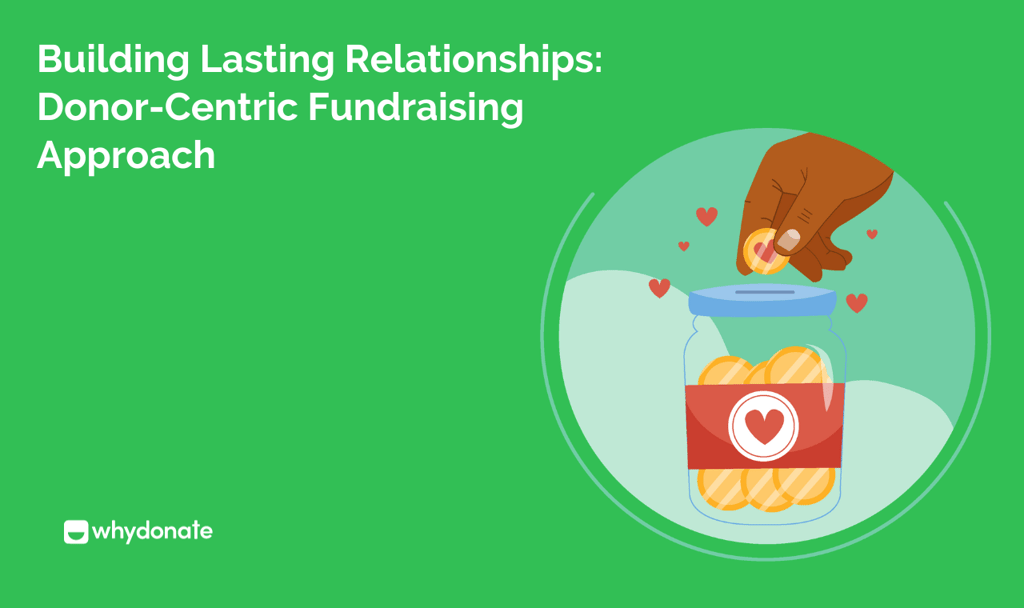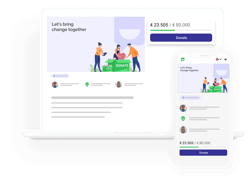In the process of building donor relationships, non-profit organizations often need to pay more attention to the power of donor retention. Building new donor relationships is crucial, but maintaining the older ones is equally important. This is where following a donor-centric fundraising approach comes into action.
In this blog, we’ll delve into the exploration of complete donor-centricity. We’ll learn about the best donor-centric fundraising strategies to help you build better donor relationships. Remember to check out the most asked questions at the end of this blog. Let’s get started!
- Are Money Problems Making Your Aspirations Fall Short? Start Fundraising For Free Today!
Table of Contents
What Is Donor-Centered or Donor-Centric Fundraising?
As the name suggests, a donor-centric approach to fundraising is simply focusing on fundraising efforts where the donors are superior. All the fundraising processes are done by keeping the donors in mind and ensuring they feel more connected to the cause or organization. This approach helps non-profits to have better relationships with their donors, ensuring long-term support from them.
Research on “How Traditional and Donor-Centered Fundraising Compare on Retention and Gift Value” shows the exact importance of a donor-centred approach to fundraising.
Have a precise look:
| Performance Measures | Traditional Fundraising Efforts | Donor-Centered Fundraising Efforts |
| Chances Of Contributing Again | 35% | 67% |
| Chances Of Making A Bigger Donation | 21.4% | 52% |
| Chances Of Long-Term Support | <10% | 67% |
What Is Donor-Centric Strategy?
To ensure proper donor-centricity, you can implement these practical tactics that will help you in donor retention and building better relationships with them:
1. Focus On A Good Donor Database
A good donor-centric fundraising strategy starts with having a good donor database. It’s an essential tool that can help you to track donations, targets, etc. It can help you in donor acquisition, donor management, and many more activities crucial for streamlining your fundraising process.
WhyDonate is the largest European crowdfunding platform and an excellent donor management software that allows you to attract donors worldwide. It also provides several features to make fundraising a cup of tea for all. It will enable you to customize your campaign and give it a personal touch.
It also lets you systematically organize your fundraisers, donors, and payout data. The best part is that the fees charged to leverage its various valuable features are absolutely zero!
- Organize Your Donor Data Systematically & Attract Donors Worldwide At WhyDonate. Start Fundraising!
2. Thank Your Donors Personally
Giving a personal touch to your thank-you letters can be a game-changer for appreciating your donors. It shows that you consider them a vital part of your initiative. Thank-you letters alone can give a sense of appreciation to your donors. Giving a personal touch can help showcase that their contribution is acknowledged and valued.
3. Publically Acknowledge Donors
Social media is a great tool to strengthen your online presence. You can use it to appreciate your donors, not just personally, but also to let others know about their generosity. Getting their permission to post them on your social media handles is crucial. After that, you can showcase appreciation on stories, posts, notes, etc.
4. Take Quarterly Donor Surveys
Donor surveys are crucial to your fundraising efforts, primarily if your organization explicitly relies on donors for funding. Donor surveys help you to take constructive feedback from your supporters and provide an opportunity to improve your fundraising processes. You can conduct a quarterly questionnaire for them and see what needs improvement.
5. Let Them Participate
Make the donors feel they are a significant part of your initiative by allowing them to participate actively. You can conduct seminars, webinars, livestreams, etc., and ask your donors to share their opinions, stories, ideas, etc.
Evidently, most donors contribute to a cause they genuinely care about. You won’t realize it, but making them participate can make them feel good about themselves and contribute to long-term collaboration and enhanced donor stewardship.
6. Maintain Transparency And Impact Reporting
Donors deserve to know where their contributions are being utilized. Since they care about your fundraising efforts, they would love to know how their contributions support your development. Impact reports connotate giving prompt updates about the utilisation of the donations. It can help new donors to build an understanding and trust in your organization/cause.
Ready to build lasting relationships with your donors? Start your fundraiser on WhyDonate today!

Benefits of Donor-Centered Fundraising
Donor-centered fundraising offers numerous benefits, helping non-profits foster deeper, more meaningful relationships with their supporters. Here are a few advantages:
Increased Donor Retention
By focusing on the needs and preferences of donors, organizations can improve retention rates. As shown in the earlier data, donor-centered efforts significantly increase the likelihood of repeated contributions and long-term support.
Stronger Donor Relationships
A donor-centric approach ensures donors feel valued, leading to stronger emotional connections and a sense of ownership in the cause.
Higher Donation Amounts
When donors feel more connected, they are more likely to contribute more generously. Research shows that donor-centric strategies increase the chances of making larger donations.
Enhanced Brand Reputation
Donor recognition and personalized engagement build trust and improve the public perception of the organization, making it more likely for new supporters to get involved.
Challenges of Donor-Centered Fundraising
While donor-centered fundraising is highly effective, it does come with its challenges. Non-profits may face several hurdles in maintaining a donor-centric approach:
Time and Resource Intensive
Implementing donor-centric practices requires consistent engagement, tracking, and personalization, which can be time-consuming and resource-intensive.
Data Management
Maintaining a comprehensive, up-to-date donor database that tracks individual preferences and giving histories is crucial but can be overwhelming without the proper tools.
Donor Fatigue
If not managed carefully, constant communication and requests can overwhelm donors, leading to burnout or disengagement. Balancing engagement without overloading donors is key.
Sustaining Long-Term Relationships
While it’s easy to start strong with a donor-centered approach, sustaining these relationships requires ongoing commitment, which may be difficult for smaller non-profits with limited staff.
Donor-Centered Fundraising and Digital Tools
In today’s fast-paced, digitally connected world, utilizing the right tools can significantly enhance your donor-centric fundraising strategy. Technology allows non-profits to better manage donor relationships, personalize communications, and track the impact of their efforts—all of which are crucial for building lasting donor relationships.
Here are some key digital tools that can help elevate your donor-centered approach:
Customer Relationship Management (CRM) Systems
A CRM system is a vital tool for managing donor data, tracking interactions, and storing crucial information that helps personalize communications. By using CRM systems, non-profits can categorize donors based on their history, preferences, and donation amounts.
CRM systems allows for targeted and customized engagement, ensuring that each donor feels recognized and valued. Some popular CRMs used in the non-profit sector include Salesforce for Nonprofits.
Email Marketing Platforms
Email marketing is one of the most effective ways to engage with donors, and digital tools like Mailchimp or Constant Contact allow non-profits to send personalized and automated messages to their donor lists.
These platforms offer segmentation options so that organizations can send tailored content based on donor interests, past donations, and other behaviors. Automated thank-you emails, newsletters, and updates on fundraising goals ensure donors stay engaged and informed.
Fundraising Platforms
Using online fundraising platforms like WhyDonate allow non-profits to easily set up and manage campaigns, making it simple for donors to give online. These platforms often offer features that help personalize the donor experience, such as custom donation forms, progress trackers, and social sharing tools. This not only makes the donation process easier but also helps with building trust and transparency.
Social Media Tools
Social media is a powerful tool for connecting with donors, sharing updates, and publicly acknowledging donor contributions. Platforms like Facebook, Instagram, and Twitter allow organizations to create engaging content, showcase the impact of donations, and communicate directly with supporters.
Tools like Hootsuite or Buffer can streamline social media management, allowing you to schedule posts, monitor engagement, and measure success.
Donor Engagement Analytics
Digital tools can also provide valuable insights into donor behavior. Analytics tools like Google Analytics or more specialized platforms like DonorSearch and Blackbaud’s Luminate can track key metrics such as website visits, donation frequency, and the average amount donated.
By understanding these behaviors, organizations can refine their donor engagement strategies and focus on the donors who are most likely to contribute again.
By leveraging these digital tools, non-profits can make their donor-centered strategies more efficient and scalable. Not only does this enhance the donor experience, but it also helps organizations save time, reduce errors, and focus on building long-term, meaningful relationships.
Your donors deserve the best! Start a fundraising campaign on WhyDonate and give them a meaningful experience.
Ending Note!
In a nutshell, following donor-centricity can be an excellent practice to retain your existing donors. It can not only help you to build permanent connections but also foster growth for your organization. The tips mentioned above are easy to implement and practical for real-life applications.
These practices can be followed by non-profits, regardless of their size, as well as individuals running personal fundraising campaigns. If you’re struggling with funding, we suggest you start a fundraising campaign at WhyDonate at a 0% platform fee. Happy Fundraising!
FAQs (Frequently Asked Questions)
What is the difference between donor-centric and community-centric fundraising?
The primary difference between donor-centric and community-centric fundraising lies in their names. Donor-centricity focuses on making the donors feel valued and appreciated, whereas community-centric fundraising focuses on connecting different communities with you.
What is donor centricity?
Donor-centricity implies following certain practices that revolve around donor satisfaction. It involves tailoring communication, strategies, and actions to foster strong relationships with donors, understand their motivations, and ensure their experience and expectations are at the forefront of the organization’s activities.
How do you become a donor-centric?
To become donor-centric, follow the following approaches:
- Focus On A Good Donor Database
- Thank Your Donors
- Publically Acknowledge Their Contributions
- Take Donor Surveys
- Let Them Participate
- Maintain Transparency And Impact Reporting
What is major donor fundraising?
Major donor fundraising involves targeting and soliciting more significant donations from individuals, organizations, or entities capable of making substantial financial contributions to a cause or organization.



















